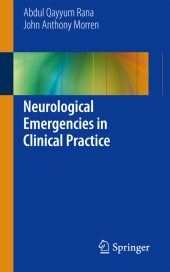 Neuerscheinungen 2013Stand: 2020-01-07 |
Schnellsuche
ISBN/Stichwort/Autor
|
Herderstraße 10
10625 Berlin
Tel.: 030 315 714 16
Fax 030 315 714 14
info@buchspektrum.de |

John A. Morren, Abdul Q. Rana
(Beteiligte)
Neurological Emergencies in Clinical Practice
2013. 2013. xvii, 203 S. 26 SW-Abb., 6 Tabellen. 203 mm
Verlag/Jahr: SPRINGER, BERLIN 2013
ISBN: 1-447-15190-9 (1447151909)
Neue ISBN: 978-1-447-15190-6 (9781447151906)
Preis und Lieferzeit: Bitte klicken
This book discusses neurological emergencies in a stepwise fashion including stabilizing the patient, identifying the cause, and treating the underlying cause. It helps the reader develop a systematic approach towards neurological emergencies.
Neurological Emergencies in Clinical Practice discusses neurological emergencies in a stepwise fashion including stabilizing the patient, identifying the cause, and treating the underlying cause. It is useful in several settings including the emergency room, hospital in-patient service as well as the intensive care unit.
Neurological Emergencies in Clinical Practice has a wide appeal and relevance to disciplines including neurology, emergency medicine, critical care medicine, internal medicine and family medicine. Medical students and residents may use this convenient, pocket-sized book to prepare for and succeed in their training examinations and it is also useful for other house staff and practicing physicians.
Coma.- Delirium.- Dizziness and vertigo.- Facial weakness.- Giant cell arteritis/ temporal arteritis.- Guillain-Barre syndrome.- Headache.- Head injury.- Meningitis and encephalitis.- Multiple sclerosis.- Myasthenia gravis.- Neck and back pain.- Neuroleptic malignant syndrome.- Postherpetic neuralgia.- Pseudotumor cerebri/ benign intracranial hypertension.- Seizures and status epilepticus.- Spinal cord compression.- Stroke and TIA.- Syncope.- Transient global amnesia.- Visual impairments.- Appendix.
_
From the reviews:
"This quick-reference guide for commonly encountered neurological emergencies uses an outline format to present a stepwise approach to evaluating, stabilizing, and treating critically ill patients. ... It is appropriate for medical students and residents rotating through the neurology ward and ICU, as well as midlevel practitioners. ... It uses a logical approach to the bedside assessment of a critically ill patient presenting with neurological symptoms or conditions." (Jason Sebesto, Doody´s Book Reviews, December, 2013)


